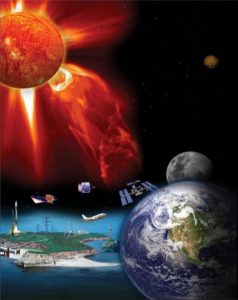June 10, 2016
Space Weather Research and Forecasting Act Introduced to Senate
Posted by bwebster
This blog post was written by Delores Knipp, Editor in Chief of AGU’s Space Weather and Space Weather Quarterly. To learn more about space weather, read Dr. Knipp’s previous post on the National Space Weather Strategy and Action Plan.
Space weather effects on technology-enabled societies were first reported in telegraph systems in the late 1840’s, with the Carrington storm of 1859 being a prime example. Furthermore, technologies developed within the last century occasionally experienced interruptions or were rendered inoperable by solar and geophysical events. Particularly vulnerable to such events are power grids and communications infrastructure. US government and space weather community reports beginning in the 1990’s and continuing to present raise concerns about the fragmentation of space weather monitoring and forecasting efforts within the federal government, and the lack of coordination at regional and state levels for response to extreme events. Indeed mitigating the negative effects of space weather is a task taken up by various departments and agencies, yet the expected cooperation and coordination is sometimes seen as halting or sporadic. Budget uncertainties have exacerbated these problems.
To address these issues Senator Gary Peters (D-MI) along with co-sponsors: Senators Cory Gardner (R-CO) and Cory Booker (D-NJ) introduced Senate Bill 2817 – Space Weather Research and Forecasting Act. In essence this bill mandates coordination across the whole of the federal government needed for implementing many aspects of the National Space Weather Action Plan (SWAP) that was introduced to the public in October 2015 (see also Lanzerotti, 2015 and Jonas and McCarron, 2016). With the Space Weather Research and Forecasting Act, Congress is requiring “clear roles and accountability of Federal departments and agencies” be established for “…efficient and effective response to threats posed by space weather.”
The bill was marked-up by the Senate Committee on Commerce, Science, and Transportation on April 27 2016 to include wording related to the important roles of academia and the commercial space weather sector and to explicitly include a Federal Aviation Administration role in assessing the vulnerability of the national airspace system to space weather events.
If passed by both the Senate and the House the bill would direct the President’s Office of Science and Technology Policy (OSTP) to: 1) improve the nation’s ability to deal with the potentially devastating impacts of space weather events; 2) coordinate the activities of various agencies; and 3) develop an integrated strategy for solar and solar wind observations beyond the lifetime of current assets. The bill also directs establishment of an interagency working group to assess existing data and models related to space weather and develop benchmarks for measuring solar disturbances.
 In the realm of hazard warning and mitigation, the bill directs the National Oceanic and Atmospheric Administration (NOAA) to inform appropriate Cabinet level departments about space weather hazards to protect critical infrastructure and directs the National Security Council to develop mechanisms to protect national security assets from space weather threats.
In the realm of hazard warning and mitigation, the bill directs the National Oceanic and Atmospheric Administration (NOAA) to inform appropriate Cabinet level departments about space weather hazards to protect critical infrastructure and directs the National Security Council to develop mechanisms to protect national security assets from space weather threats.
To some degree language in the bill codifies what is already being done, but does so in a way that insures these activities have the weight of a congressional mandate when it comes to the annual funding cycle. For example, NOAA is to secure reliable secondary capability for near real-time imagery of magnetized plasma ejections (coronal mass ejections) from the Sun; and to develop requirements and a plan for follow-on space-based observations for operational purposes. Similar ground-based observation requirements are directed at the National Science Foundation (NSF) and the Air Force, with each required to prioritize and maintain ground-based observations of the Sun and other relevant ground-based space weather data.
Other aspects of the bill mandate more interagency cooperation between Department of Defense, NASA, NOAA and NSF. Agencies with space weather research budgets are tasked to continue research in solar physics, space physics, and space weather, with NASA specifically required to implement missions meeting science objectives identified in the Decadal Surveys of Solar and Space Physics by the National Academies. The bill also requires that appropriate research results be transitioned to civilian and military space weather operational forecasting centers and that research modeling centers and forecasting centers coordinate their efforts.
Taxpayers might expect that an “act of Congress” would not be needed to get federal agencies to act for the collective good when it comes to hazards that could affect large segments of the US citizenry and economy. The root of these disconnects sometime lies in the Congressional acts that created agencies, or in the annual funding profiles, or just in the nature of bureaucracies. While an act of Congress is unlikely to resolve all of these issues, Senate Bill 2817’s sponsors clearly have in mind a long-term plan to put teeth in the Space Weather Action Plan.


